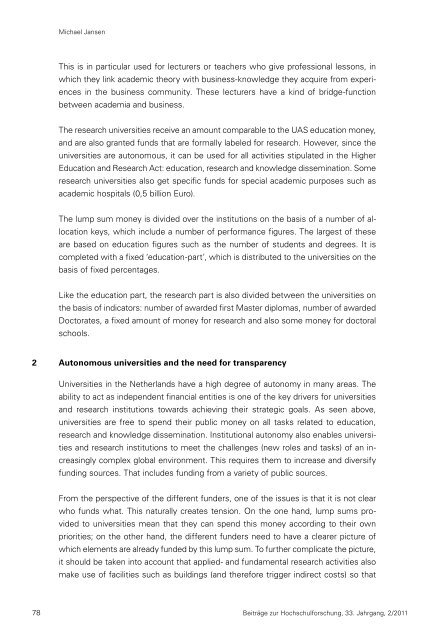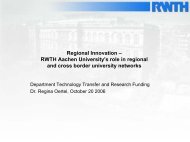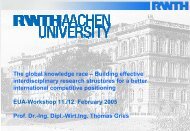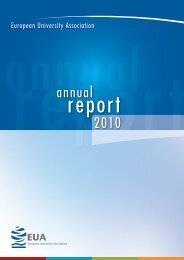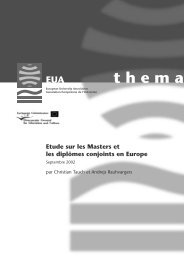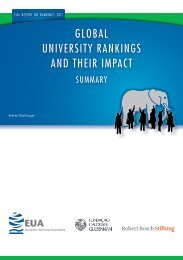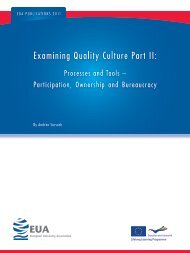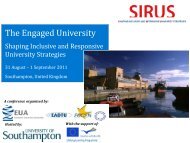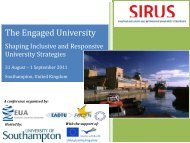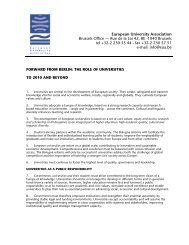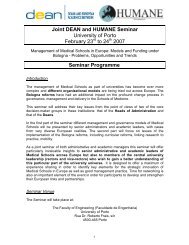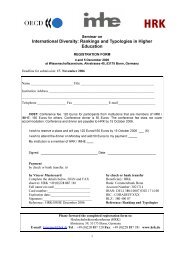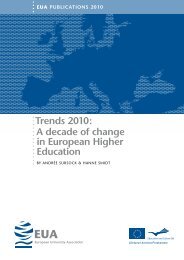Beiträge zur Hochschulforschung - European University Association
Beiträge zur Hochschulforschung - European University Association
Beiträge zur Hochschulforschung - European University Association
Create successful ePaper yourself
Turn your PDF publications into a flip-book with our unique Google optimized e-Paper software.
78<br />
Michael Jansen<br />
This is in particular used for lecturers or teachers who give professional lessons, in<br />
which they link academic theory with business-knowledge they acquire from experi-<br />
ences in the business community. These lecturers have a kind of bridge-function<br />
between academia and business.<br />
The research universities receive an amount comparable to the UAS education money,<br />
and are also granted funds that are formally labeled for research. However, since the<br />
universities are autonomous, it can be used for all activities stipulated in the Higher<br />
Education and Research Act: education, research and knowledge dissemination. Some<br />
research universities also get specific funds for special academic purposes such as<br />
academic hospitals (0,5 billion Euro).<br />
The lump sum money is divided over the institutions on the basis of a number of al-<br />
location keys, which include a number of performance figures. The largest of these<br />
are based on education figures such as the number of students and degrees. It is<br />
completed with a fixed ‘education-part’, which is distributed to the universities on the<br />
basis of fixed percentages.<br />
Like the education part, the research part is also divided between the universities on<br />
the basis of indicators: number of awarded first Master diplomas, number of awarded<br />
Doctorates, a fixed amount of money for research and also some money for doctoral<br />
schools.<br />
2 Autonomous universities and the need for transparency<br />
Universities in the Netherlands have a high degree of autonomy in many areas. The<br />
ability to act as independent financial entities is one of the key drivers for universities<br />
and research institutions towards achieving their strategic goals. As seen above,<br />
universities are free to spend their public money on all tasks related to education,<br />
research and knowledge dissemination. Institutional autonomy also enables universi-<br />
ties and research institutions to meet the challenges (new roles and tasks) of an in-<br />
creasingly complex global environment. This requires them to increase and diversify<br />
funding sources. That includes funding from a variety of public sources.<br />
From the perspective of the different funders, one of the issues is that it is not clear<br />
who funds what. This naturally creates tension. On the one hand, lump sums pro-<br />
vided to universities mean that they can spend this money according to their own<br />
priorities; on the other hand, the different funders need to have a clearer picture of<br />
which elements are already funded by this lump sum. To further complicate the picture,<br />
it should be taken into account that applied- and fundamental research activities also<br />
make use of facilities such as buildings (and therefore trigger indirect costs) so that<br />
<strong>Beiträge</strong> <strong>zur</strong> <strong>Hochschulforschung</strong>, 33. Jahrgang, 2/2011


